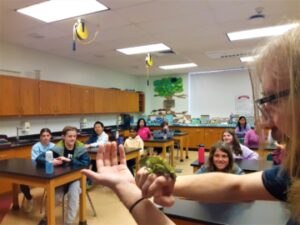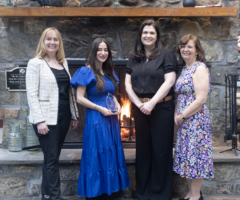 As Earth Month comes to an end, it is apparent we all have a role in protecting our planet.
As Earth Month comes to an end, it is apparent we all have a role in protecting our planet.
Briarcliff Middle School students recently had a special lesson about climate change which inspired students and demonstrated how changing environment impacts all living things.
Patrick Harmon, an environmental educator from the Putnam Northern Westchester BOCES, visited Julie Gallagher’s sixth grade class and presented a program called Climate Change.
“The subject ties in to our current unit in science class, which is climate and weather,” Gallagher said.
Harmon showed students a PowerPoint presentation with photos of various animals who live in different habitats and how climate change can affect them. He also showed students maps of certain places around the world that in 40 years will be inhabitable due to global warming.
“There are many people today who are working to save the environment,” Harmon said.
He told students a story about two high school girls who started a nonprofit organization with a mission to reduce waste in their communities.
“They went to high school cafeterias, grocery stores and restaurants and collected food waste and composted it,” he said.
He discussed composting and asked students to suggest other ways of reducing waste.
Students suggested recycling, using reusable water bottles and buying clothes at thrift shops.
Harmon showed students photos of leaders in the field of environmentalism, including law makers, scientists, musicians and writers, all who are dedicated to doing their part to help battle climate change.
He asked students to discuss in small groups ways that they can make a difference at home or at school.
“I noticed that in the cafeteria kids don’t always put recyclables in the bin, but throw them in the trash,” said Devna. “I want a stricter system: maybe a student volunteer can monitor them.”
Afterwards, students shared their ideas with the class.
Their ideas included avoiding using plastic utensils, walking to school or taking public transportation, saving leftovers instead of throwing them out and taking books from the library instead of buying them.
Towards the end of the lesson, as a surprise, Harmon introduced a special guest: Louise, a crested gecko.
“This is a species that has been deeply impacted by climate change,” Harmon said. “About 30 years ago it was thought to be extinct, but in the mid-nineties, a few crested geckos were found in New Caledonia, which is an island in the South Pacific.”
According to Harmon, due to breeding programs, crested geckos are now available as pets.
He showed the students how Louise can jump from one hand to another. He also walked around the room and students had a chance to take a closer look at her.
“In the wild she is an herbivore and eats mostly fruits and vegetables,” he said. “She can also change the color of her scales.”
Harmon told the students that her species is still under threat by climate change and human development.
“She is only one of many species under threat – this is why it is so important that you, as our future leaders, help protect species like her,” he said. “We also have to protect the human species. We only have one planet; we have nowhere to go if this one becomes unlivable.”
Harmon typically presents this program to students in elementary schools but finds the benefit in presenting it to older students.
“With older students, I can hear what their suggestions are for saving the environment and I also like to find out what they are already doing,” he said. “We try to make this program engaging and interactive to inspire students to get involved.”







Nothing like indoctrinating the young. Anyone with a brain knows that climate change/ global warming is a fraud. Democrats themselves don’t believe it .
/